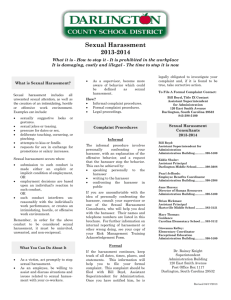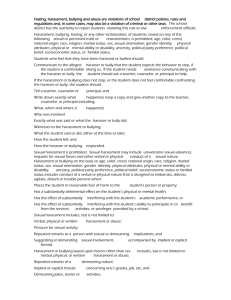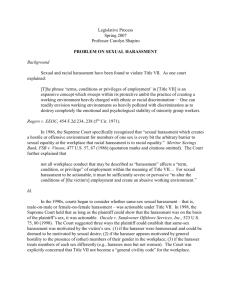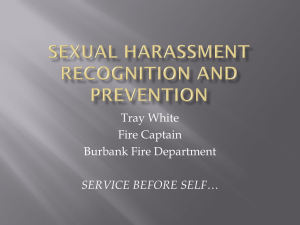How to Win Sexual Harassment Cases
advertisement
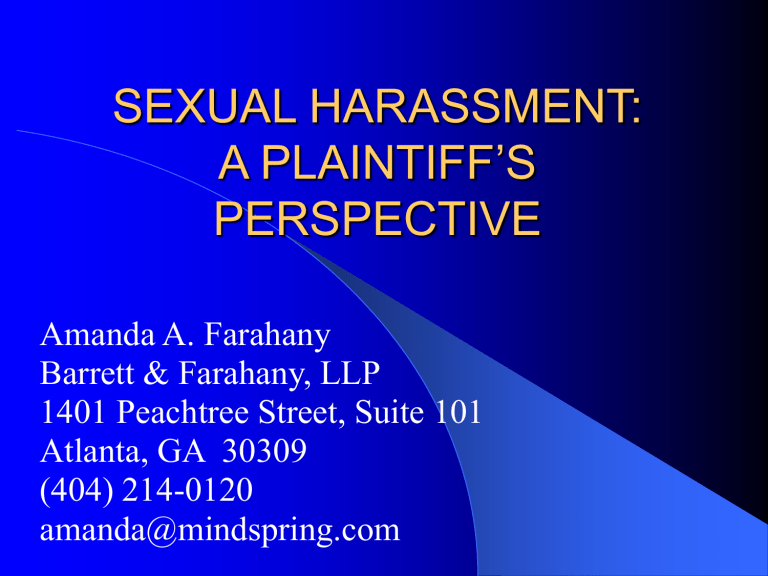
SEXUAL HARASSMENT: A PLAINTIFF’S PERSPECTIVE Amanda A. Farahany Barrett & Farahany, LLP 1401 Peachtree Street, Suite 101 Atlanta, GA 30309 (404) 214-0120 amanda@mindspring.com Sexual Harassment Importance of Sexual Harassment Cases Juror Bias Dealing with the Client Tangible Employment Action Attacking the Affirmative Defense Sexual Harassment Harassment in the workplace is harmful to all involved – Hurts the Plaintiff – Captive Victim – Harms the work environment – Less productive employees – Employee turnover Juror Bias in Sexual Harassment Cases Jurors seek to hold the Plaintiff responsible – Blame the victim – Woman’s job to enforce the limits on men’s sexual behavior – “She shouldn’t have …” Lack of physical injury Lack of witnesses False accusations Juror Bias in Sexual Harassment Cases Sexual assault is the only crime that places the onus on the survivor. If an assailant held you at knifepoint, asked for your wallet and you complied, there is no question that a crime was committed. You would not be asked if you had consented. You would not be asked if you had tried to resist. Dealing with the Client Victimized by the harasser, the employer and often the system Treat with kid gloves Bring the person in to office to discuss – – – – – Do not meet with at your desk Do not judge Do not chastise Be absolutely honest with the client Explain the law and their case Dealing with the Client Fully explore the facts of the case – The actual harassment “You know it when you see it” – The policies and procedures – Prior complaints of harassment – Do not always turn away because client did not complain Investigation Key to successful litigation More information available to plaintiff than other discrimination claims Look for pattern from harasser Know your client – Investigate your client’s background Investigation Investigate the harasser – Order a criminal history of harasser from GCIC (or state Crime Information Center) – Check for litigation history on Pacer and places the harasser has lived – Check litigation for any prior places of harasser’s employment – Call any prior employers for reference for harasser Always file suit against the harasser Investigation Contact every possible witness – Often times circumvent prohibition of speaking to employees because not in management Prior victims important Prior employees supervised by harasser Follow up on any rumors Always ask for other possible witnesses Investigation Talking to witnesses – Policies and Procedures – Dissemination of procedures – Reporting procedures – Successfulness of reporting any problems Information is admissible of reputation of harasser and prior bad acts to prove notice Tangible Employment Actions Employers strictly liable for actions of supervisor when the harassment results in a tangible employment action – Entails a change in economic situation – Research constructive discharge – Remember promotions and hiring Affirmative Defense Employer must prove that it took reasonable steps to prevent and correct promptly any harassment that occurred AND That the employee failed to take advantage of any preventive or corrective opportunities or to otherwise avoid harm Reasonable Steps to Prevent Hiring the harasser – Application process Background investigation Criminal checks Reference checks Review application for inconsistencies to put on notice Training the supervisors to respond Attacking the Policy 20-26% of sexual harassment reported Expectation of adverse consequences Fear of embarrassment Fear that nothing will be done Desire not to hurt harasser Attacking the Policy Does it encourage victims to report the harassment? – Without fear of reprisal and retaliation? – Does it require reporting to the harasser? – Does it provide alternate routes of reporting? – Does it obligate the victim to talk to the harasser first? – Does it require all employees to report? Attacking the Policy Does it allow for reporting to a member of the same sex? Does it require a formal written complaint? Is there an assurance that something will be done? Does it described the action to be taken if sexual harassment is found? Does responsive action include training and referral to counseling? Attacking the Policy Does it require that the victim prove the allegation, and threaten that false or unproven allegations will result in reprimand or termination? Warnings of discipline if found to groundless or frivolous? Attacking Dissemination Is the policy well disseminated? Can they prove that your client received it? Will other witnesses testify that it wasn’t disseminated? Was it disseminated in the same manner as other important company policies? Attacking the Remedial Action Was the employee immediately separated to avoid additional harm? Was the victim required to take additional steps once she reported the harassment? – Refused to investigate without written complaint – Refused to investigate without witnesses Was an investigation done promptly? How was the investigation conducted? Attacking the Remedial Action Did they choose not to believe the victim because there was no corroboration? Action taken calculated to end harassment? Did the harassment continue? Investigation, even those by counsel, may not be privileged if asserting the defense Showing Reasonableness in Not Reporting Generalized fear not enough to warrant failure to report How were prior complaints of sexual harassment handled? – Was the plaintiff aware of them? How were other complaints handled? Can the policy be shown to have worked? Other Things to Remember Federal Rule of Evidence 412 – Limits the types of questions and areas of inquiry into the victim’s past Mental Examination pursuant to Rule 35 – If plaintiff claims diagnosable condition or illness, may permit – Not always available in “garden variety” – Use against the harasser Conclusion Investigate, Investigate, Investigate Know your case Know the law Talk to other Plaintiff lawyers Join NELA Join a list-server – For Georgia, contact me at amanda@mindspring.com
